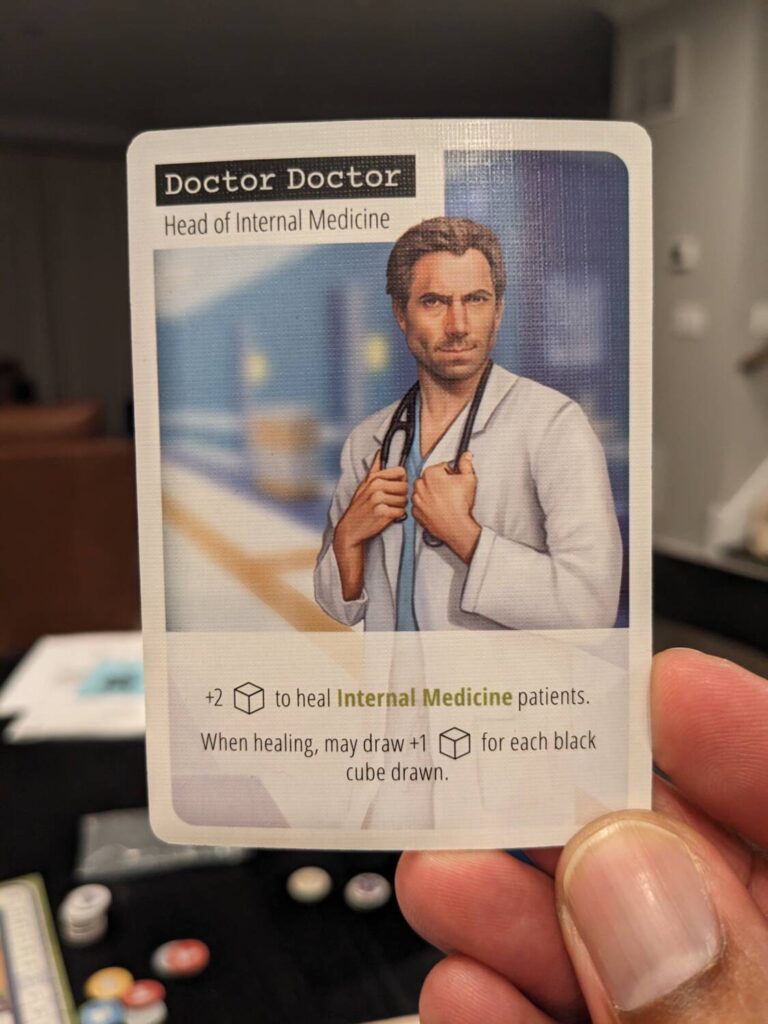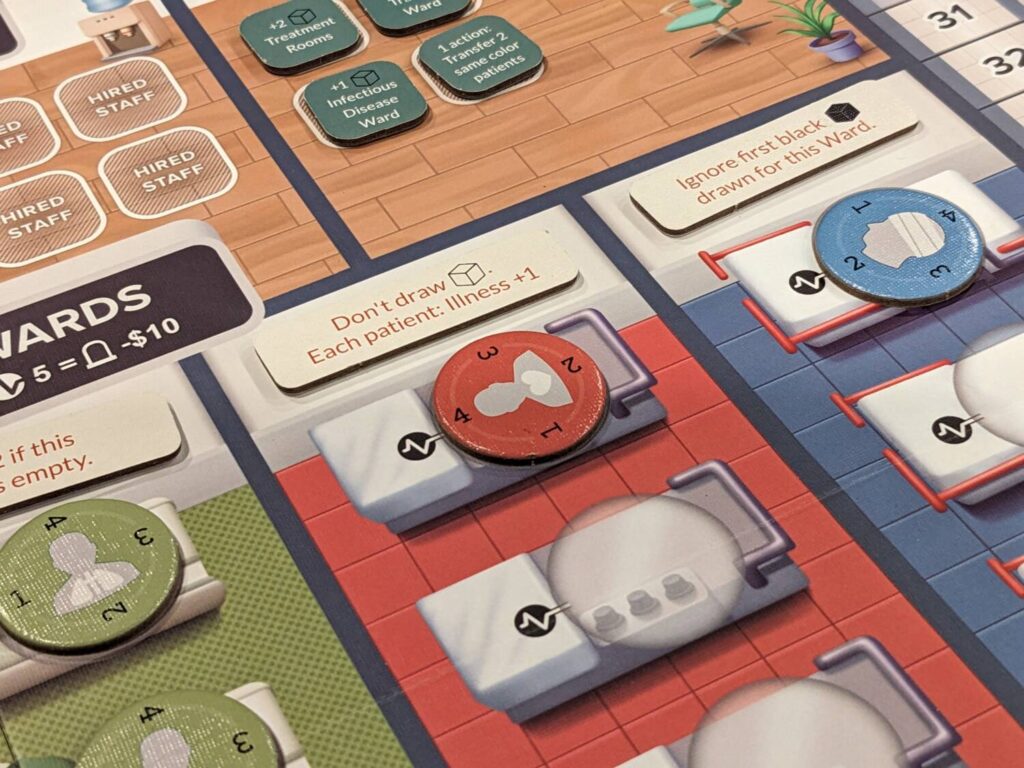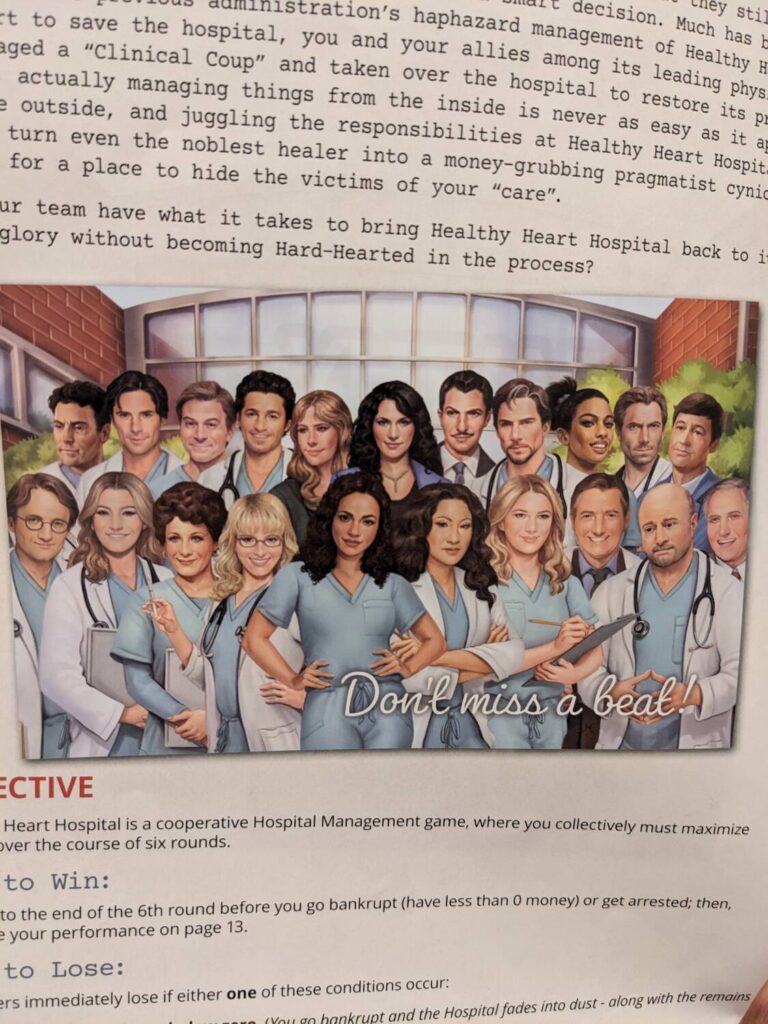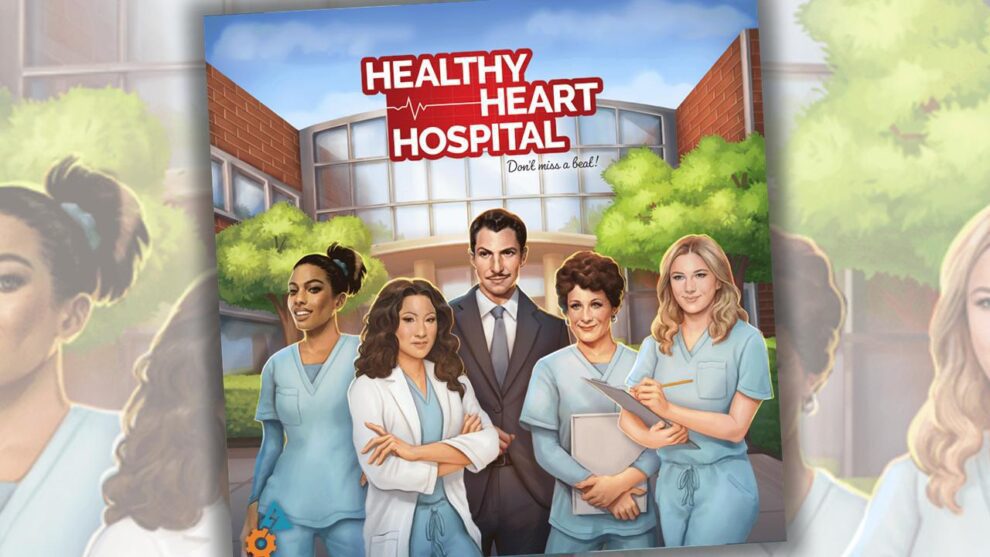Disclosure: Meeple Mountain received a free copy of this product in exchange for an honest, unbiased review. This review is not intended to be an endorsement.
About two years ago, my buddy Johnivan showed up at a game night with a copy of the 2015 co-op game Healthy Heart Hospital. The cover looks like a newspaper ad out of the 1950s, right down to the game’s tagline, “Don’t miss a beat!” written in script just below the title.
We didn’t get to play Healthy Heart Hospital that night, but Johnivan still opened up the box and showed me the components. It was basic-looking stuff but I loved the retro-style art, and the package looked like something that could use an upgrade. When Tabletop Tycoon reached out to offer a review copy of the new version of this game, I remembered Johnivan’s copy and offered to cover the new edition.
Healthy Heart Hospital (Third Edition) is the 2023 update of the 2015 original, with that 2015 version based on an earlier game called Triage. The art style has been altered to a much more generic looking game that has the look of something like TV hospital dramas such as General Hospital and St. Elsewhere, but as if these shows appeared on Lifetime.
If you are going to try Healthy Heart Hospital, this edition is the way you want to do it. But…do you want to do it?

Doctor Doctor
Healthy Heart Hospital is a cooperative 1-5 player game forcing players to manage the care of patients in the five wards of the hospital as well as the waiting rooms and the overall business of the facility. Over six rounds, the goal is simple: don’t run out of money, and don’t run out of space for the dead bodies that will pile up over the course of play. The game ends immediately if one of those two conditions is met. Otherwise, at the end of six rounds, players check a high-score track to see how they did based on the amount of money left in the company coffers.
Even though Healthy Heart Hospital accommodates five players, I played the game solo three times. That’s because one pass of the rules reveals the truth—co-op games where all players decide the actions of all other players means that more players just add more time. (I think the ideal count would be two players here, and BGG seems to agree.) Solo play is interesting because the game just asks solo players to pick a number of other doctors to manage, so you can scale solo up or down depending on how much time you have. I did two solo plays with two doctors and one play with four doctors.
Each player is assigned a doctor card, each with two special powers that can be used every round. Also, the players manage an administrator, which has different powers like the ability to hire staff and conduct research, which may or may not grant extra powers during a round. (In another nod to the solo nature of play, the administrator role passes to a new player each round, but players collectively decide how to best use the administrator’s actions. It isn’t clear to me why this is an assigned role when it would be better to just have all players manage all doctor and administrator roles since players take turns in any order they choose.)
In a round of the standard version of the game, each doctor gets two actions, which can be used to heal and/or transfer patients. Administrators have a once-per-round special power, as well as the ability to hire staff and do “research” to give the doctors better and/or discounted actions.

Healthy Heart Hospital essentially comes down to a single question: how random do you want your games to be? That’s because no matter how I sliced it, each game played out the same way. I would come up with a plan each round based on the odds of drawing the right types of cubes to heal patients, then hope that I would draw cubes to heal the matching-color patients in one of my wards.
Patients are represented by small discs in wards, and cubes in the waiting room. When the discs or the cubes reaches level five, a patient dies, so healing patients just enough so that they don’t die (earning a dollar each time a patient is healed in the ward, and more money if you have a treatment room matching the patients in a specific ward) becomes one of the tools needed to keep the hospital in business.
I was shocked by how often I would play the odds based on the number of cubes remaining by color, and still unintentionally murder patients in one of my wards. Each round’s clean-up step includes adding more cubes to your waiting rooms, but if you draw too many of one color, that’s going to trigger a level-five patient, which immediately becomes a dead body.
Dead bodies hurt players when considering the end-game conditions. Patients who die cost the hospital $5-$10 each, and the base game’s morgue only has room for five dead bodies. Murder a sixth person, and the game ends. I only won one of my three games, and of my failed attempts to build up my hospital, I lost one of those two games during the third round!

A $150 Token?
At the beginning of a 1-4 player game, players start with $15 in the bank, less for a five-player game. Even in my best rounds, I was never scoring $20 in a round. In the game I won, I ended play with $46, a middling score according to the game’s high-score chart.
But the game comes with a bank tracker token that is used when the bank exceeds $100, then $150. I’m still trying to figure out any scenario where a player could score $150 across six rounds. Even $100 seems ridiculous…maybe a series of lucky draws, mixed with the right kinds of treatment rooms that offer more cash for successfully healing (not curing, healing) patients, maybe using the staff or research bonuses that can add flat amounts of cash to the kitty?
Healthy Heart Hospital doesn’t take itself too seriously, so I’m trying to match its tone by acknowledging that it’s not about the result,it’s about the journey. Still, this journey feels like bookkeeping. I spent a lot of time reaching into a cloth bag to shuffle and remove one of the 88 cubes. Only eight of those cubes are black—always signifying negative effects—but it feels like a black cube is almost always coming out at the wrong time.
Something else really bugged me about Healthy Heart Hospital: this might be the whitest hospital in board game or TV history. Of the 21 doctor and administrator cards, 19 of them (!!!) represent characters that appear to be white. The game includes one Black nurse and one Asian doctor. That’s it. Heck, this edition of the game is whiter than the 2015 version of the game, which featured a Black doctor as one of two characters on the cover!!
I can’t think of many games that somehow got less diverse by releasing newer versions. Now, full disclosure: I’m more biased than others. I’m Black, the guy who recommended the 2015 version at that game night is also Black, my main gaming group is majority minority, my city (Chicago) is 67% non-white, and I’m a diversity, equity & inclusion practitioner for my day job. Healthy Heart Hospital is almost the complete opposite of the world I occupy.
I know that the game is trying to mock shows like ER and doctors like the one Patrick Dempsey played on Grey’s Anatomy. On those shows, the majority of the hospital staff members are white. Sure, got it. STILL…come on, board games!

Check Your Pulse
Healthy Heart Hospital—designed, like the previous versions, by Scott and Anna-Marie Nelson—does some good things, but it ultimately is a game that feels like an exercise more than an opportunity to amaze.
I haven’t played the older versions, so I can’t speak to whether Healthy Heart Hospital got better or not with this newest iteration. I enjoyed the way the game pokes fun at trying to run a hospital, and while I appreciate that the game can accommodate a lot of players, I think the sweet spot with Healthy Heart Hospital is to play it solo or with maybe one additional person.
The production is clean, the rules are an easy read, and setup and teardown are a breeze. My games lasted about 45 minutes each, just like the box says. (My three-round game didn’t take that long, though; you can lose this game in a flash!) With 14 doctor cards, players will have a lot of variety out of the box.
But the big wow moments here come when drawing cubes and you happen to draw more of the cube color for a particular patient than you were expecting. I never had those clever turns that I love in my favorite games, and approaching this as a pure strategy game is not possible thanks to the randomness of the cube draw, and to a small degree drawing cards during the research action.
After my third play of Healthy Heart Hospital, I had a desire to pull out Clinic: Deluxe Edition, the hospital management strategy game designed by Alban Viard. While Clinic is a significantly heavier lift than Healthy Heart Hospital, I think I like managing my hospital by making the right choices and executing on those choices. Randomly managing my hospital by drawing cubes was not very fulfilling.











